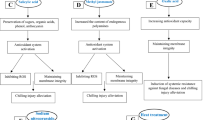Abstract
The study was carried out on the harvesting and handling methods of okra with the objective to maintain the best quality of pods from harvesting to end consumer especially for export marketing. For that purpose okra cv. ‘Punjab-8’ pods were harvested with minimum handling (least injuries to the pubescence on the ridges of pod) and normal handling (no safety taken to prevent injuries on pods). Pods were precooled at 15 ± 1ºC, 90–95% RH; jumble packed in the CFB boxes of 2.0 Kg capacity and than stored at 8 ± 1ºC, 90–95% RH. The quality parameters of okra namely texture, chlorophyll content, physiological loss in weight, rotting percentage and general appearance were studied. The pods harvested with minimum handling and field packaging can retain their green colour, crisp texture (maximum force to puncture pod = 500.2 g) with minimum rotting (3.0%) and physiological loss in weight (15.8%) and good appearance upto 13 days of cold storage whereas normal handled pods can be stored upto 5 days at 8 ± 1ºC, 90–95% RH and thereafter lost their general appearance on the 7th day of storage and were discarded. Therefore, in order to maintain high quality of okra from harvesting to the final destination (consumer), the okra pods should be harvested with minimum handling followed by field packaging in CFB boxes.


Similar content being viewed by others
References
Amerine MA, Pangborn RM, Roessler EB (1965) Principles of sensory evaluation of food. Academic, London, p5
Anonymous (2004) Annual report of punjab horticultural postharvest technology centre. P.A.U, Ludhiana
Dhall RK, Mahajan BVC, Sharma SR, Dhatt AS (2008) Effect of handling methods and postharvest treatment on the quality of fresh okra during storage. In : Proceeding of National Seminar on Food Safety and Quality from October 20–21, 2008 at Guru Jambheshwar University of Science and Technology, Hisar. pp 296–298
Hardenburg RE, Watada AE, Wang CY (1986) Commercial storage of fruits, vegetables, flowers and nursery stock. USDA Handbook No. 66
Hunter S (1975) The measurement of appearance. John Wiley and Sons, New York, pp 304–305
Jasol FS (1988) Export prospects of horticultural produce from India. Indian Hort 34:79–85
Kedar AA (1992) Postharvest biology and technology- an overview. In: Postharvest technology of horticultural crops. Second Edition, UC Davis Publication No. 3311, pp 15–20
Rangana S (1977) Manual of analysis of fruit and vegetable products. Tata McGraw Hill Publishing Company Limited, New Delhi, pp 80–83
Scholz EW, Johnson HB, Buford WR (1961) Heat evaluation rates of some Taxes grown fruits and vegetables in Rio Grande Valley. Hort Sci 17:170–175
Singh K, Pandey UB (1993) Export of vegetables- status and strategies. Veg Sci 20:93–103
Solomos T, Letties GG (1973) Cellular organization and fruit ripening. Nature 245:390–391
Uppal GS, Kamboj JS and Dhatt AS 2002. Effect of pre-packing and disinfectant and cold storage on postharvest life of Okra. In: National Workshop on newer vistas in handling and processing technology for horticultural crops, held at New Delhi on 14–15, June 2002. pp 8
Author information
Authors and Affiliations
Corresponding author
Rights and permissions
About this article
Cite this article
Dhall, R.K., Sharma, S.R. & Mahajan, B.V.C. Development of post-harvest protocol of okra for export marketing. J Food Sci Technol 51, 1622–1625 (2014). https://doi.org/10.1007/s13197-012-0669-0
Revised:
Accepted:
Published:
Issue Date:
DOI: https://doi.org/10.1007/s13197-012-0669-0




